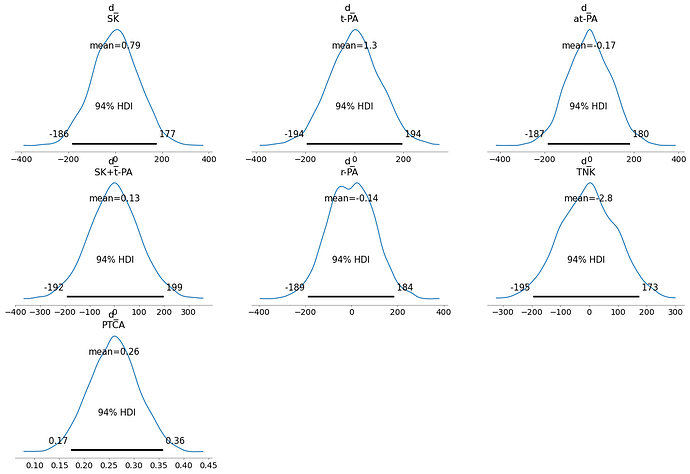I have data for 36 studies with binomial data for 7 medical treatments. For each trial I have the number of patients, and the number who had an event of interest. Most of the studies have 2 arms, but the first study has 3 arms. I am trying to write code that treats the data the same way as what is in Technical support document 2 on the NICE website, and what is in the book “Network Meta-Analysis for Decision-Making”
I wrote code for two arms, but now I want to have it handle the one case with 3 arms. Latter I will have to add a bias correction for 3 arms trials, but for now I just want to add the single case with 3 arms.
This is not a missing data problem. I would appreciate any help or suggestions on how to handle the 3rd arm.
Hopefully the code below is better formatted than on my first try.
import arviz as az
import matplotlib.pyplot as plt
import pandas as pd
import numpy as np
import pymc as pm
import pytensor.tensor as pt
import pytensor
%matplotlib inline
mport pandas as pd
import io
data_string="""studyID,na,t1,t2,t3,r1,n1,r2,n2,r3,n3,study
1,3,1,3,4,1472,20251,652,10396,723,10374,GUSTO-1 1993
2,2,1,2,,3,65,3,64,,,ECSG 1985
3,2,1,2,,12,159,7,157,,,TIMI-1 1987
4,2,1,2,,7,85,4,86,,,PAIMS 1989
5,2,1,2,,10,135,5,135,,,White 1989
6,2,1,2,,887,10396,929,10372,,,GISSI-2 1990
7,2,1,2,,5,63,2,59,,,Cherng 1992
8,2,1,2,,1455,13780,1418,13746,,,ISIS-3 1992
9,2,1,2,,9,130,6,123,,,CI 1993
10,2,1,4,,4,107,6,109,,,KAMIT 1991
11,2,1,5,,285,3004,270,3006,,,INJECT 1995
12,2,1,7,,11,149,2,152,,,Zijlstra 1993
13,2,1,7,,1,50,3,50,,,Riberio 1993
14,2,1,7,,8,58,5,54,,,Grinfeld 1996
15,2,1,7,,1,53,1,47,,,Zijlstra 1997
16,2,1,7,,4,45,0,42,,,Akhras 1997
17,2,1,7,,14,99,7,101,,,Widimsky 2000
18,2,1,7,,9,41,3,46,,,DeBoer 2002
19,2,1,7,,42,421,29,429,,,Widimsky 2002
20,2,2,7,,2,44,3,46,,,DeWood 1990
21,2,2,7,,13,200,5,195,,,Grines 1993
22,2,2,7,,2,56,2,47,,,Gibbons 1993
23,2,3,5,,13,155,7,169,,,RAPID-2 1996
24,2,3,5,,356,4921,757,10138,,,GUSTO-3 1997
25,2,3,6,,522,8488,523,8461,,,ASSENT-2 1999
26,2,3,7,,3,55,1,55,,,Ribichini 1996
27,2,3,7,,10,94,3,95,,,Garcia 1997
28,2,3,7,,40,573,32,565,,,GUSTO-2 1997
29,2,3,7,,5,75,5,75,,,Vermeer 1999
30,2,3,7,,5,69,3,71,,,Schomig 2000
31,2,3,7,,2,61,3,62,,,LeMay 2001
32,2,3,7,,19,419,20,421,,,Bonnefoy 2002
33,2,3,7,,59,782,52,790,,,Andersen 2002
34,2,3,7,,5,81,2,81,,,Kastrati 2002
35,2,3,7,,16,226,12,225,,,Aversano 2002
36,2,3,7,,8,66,6,71,,,Grines 2002"""
data=pd.read_csv(io.StringIO(data_string),sep=",")
trials=data[["n1","n2"]]
events=data[["r1","r2"]]
trt=data[["t1","t2"]].to_numpy()-1
N=len(trials)
studies=data["study"]
treatments=["SK","t-PA","at-PA","SK+t-PA","r-PA","TNK","PTCA"]
coords = {"studies": studies, "treatments":treatments}
reference=np.array([0,1,1,1,1,1,1])
with pm.Model(coords=coords) as femodel:
r=pm.MutableData('r',events)
n=pm.MutableData('n',trials)
t=pm.MutableData('t',trt)
d_=pm.Normal("d_",mu=0,sigma=100,dims="treatments")
d=pm.Deterministic("d",d_*reference,dims="treatments")
mu=pm.Normal("mu",mu=0,sigma=100,dims="studies",shape=(N,1))
dm=pm.Deterministic("dm",d[t])
linpred=pm.Deterministic("linpred",mu+dm)
p=pm.Deterministic("p",pm.invlogit(linpred))
y=pm.Binomial("y",n=n,p=p,observed=r)
fedata=pm.sample(10000,tune=5000, nuts_sampler="nutpie")
pm.model_to_graphviz(femodel2)
pm.model_to_graphviz(femodel2)
